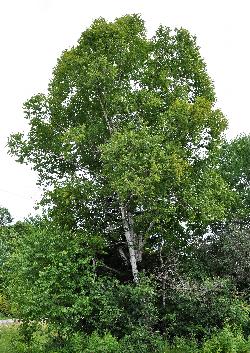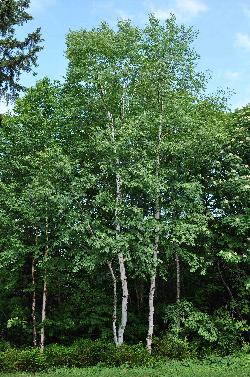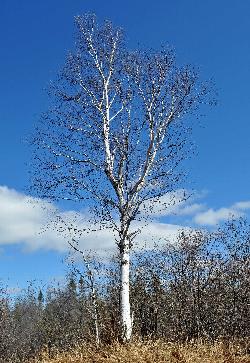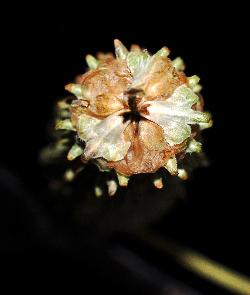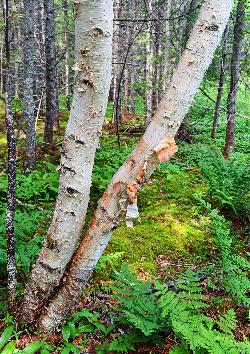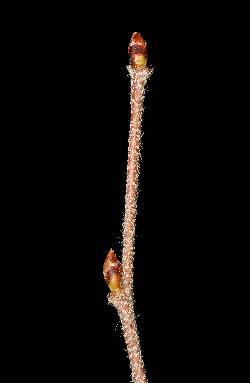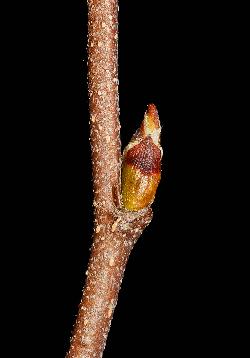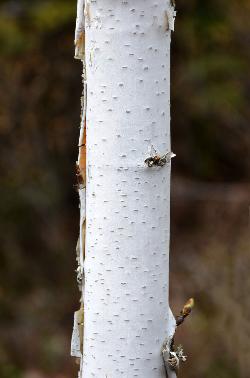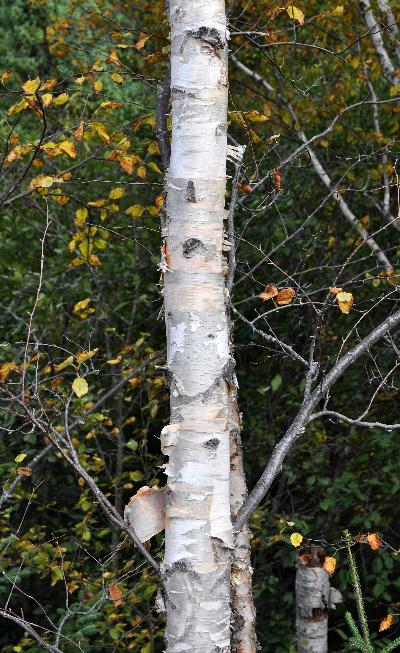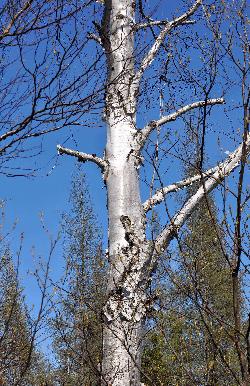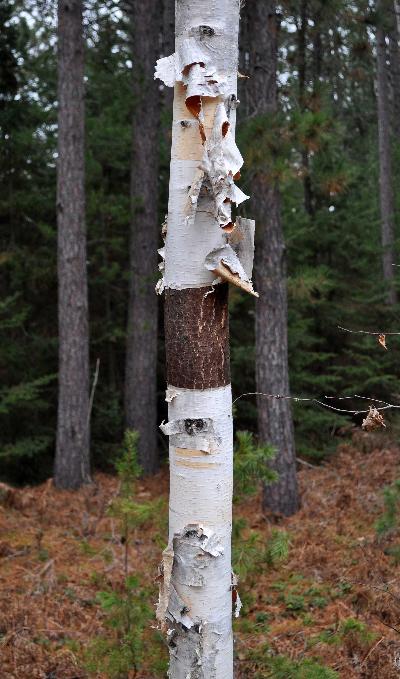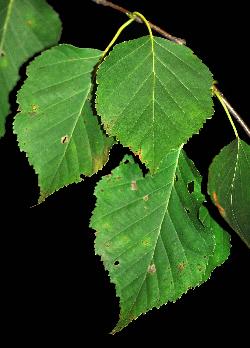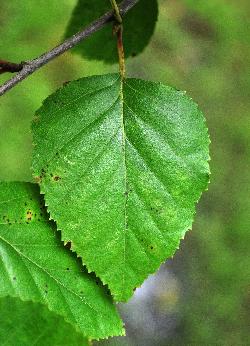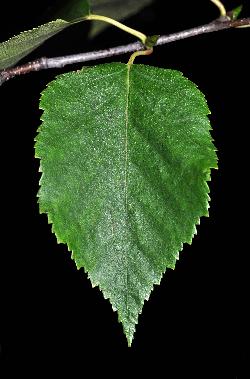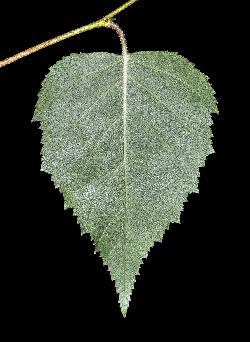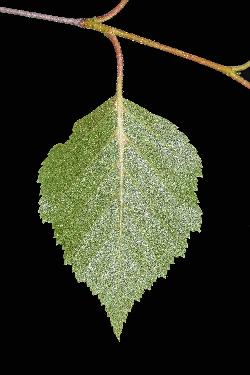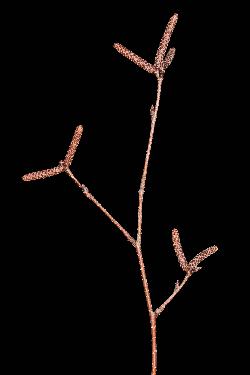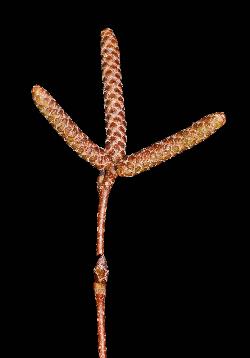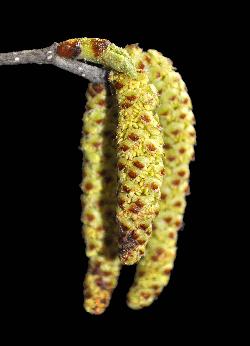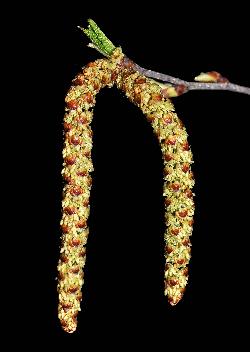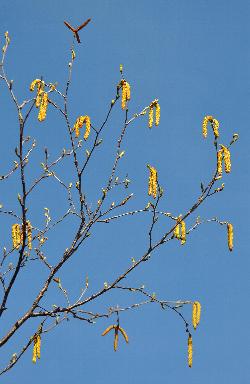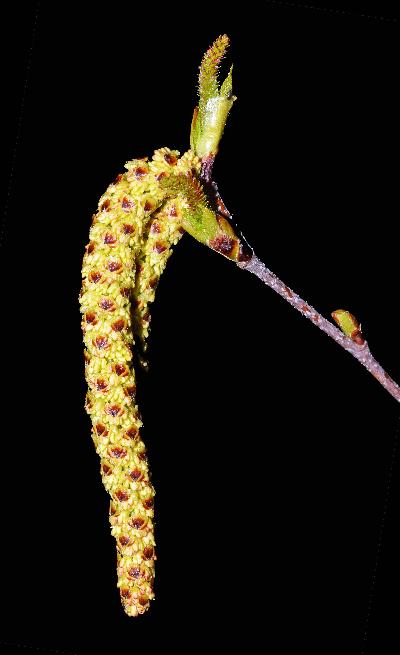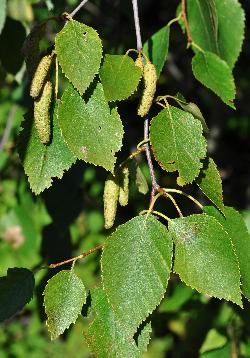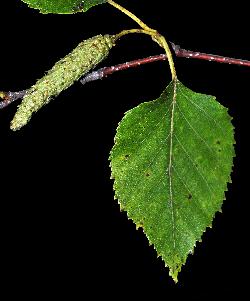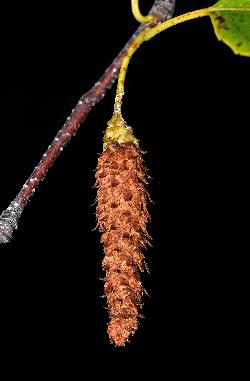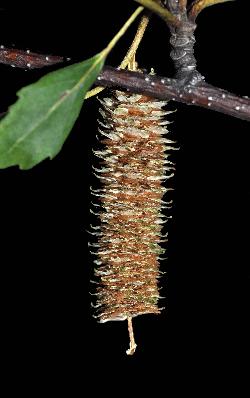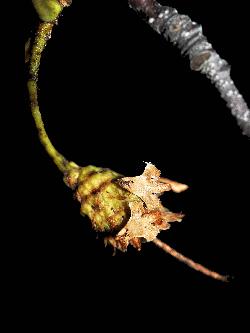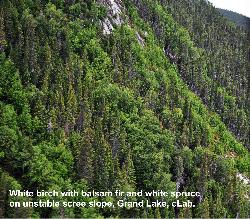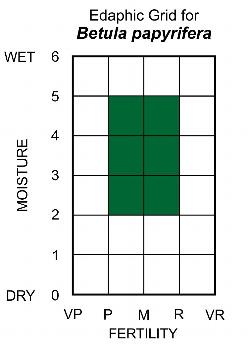Fr: bouleau à papier, bouleau blanc, bouleau à canot
IA: pitaushkuai, pitushkuai, ushkuai
Betulaceae - Birch Family
Note: Numbers provided in square brackets in the text refer to the image presented above; image numbers are displayed to the lower left of each image.
General: A medium-sized deciduous tree, with spreading to ascending branches [1–4]; white birch is usually 20–25 m tall, with a d.b.h. of 20–40 cm, and can live 140–200 yrs., although maturity is reached at 60–70 yrs. (Safford et al. 1990). White birch is a fast-growing, short-lived, pioneer species that is shade-intolerant and shallow-rooted, and has variable morphological traits, particularly in leaf shape and pistillate scale shape. Stump sprouts often develop after cutting or fire. White birch regeneration provides browse for moose; mature trees provide plentiful fruit for small birds, such as redpoll, pine siskin, and chickadees, while ruffed grouse are known to feed of flower and vegetative buds (Safford et al. 1990). White birch is also used commercially as a source of plywood, specialty wood items (Meier 2015), firewood, and for landscaping. Historically, the waterproof bark of white birch was used by the Beothuk in Newfoundland to construct canoes (Marshall 1998).
Key Features: (see images indicated below)
- Leaves generally have tapering (cuneate), rounded, or flat (truncate) leaf bases [5–6], but occasional leaves with somewhat cordate bases may also be found.
- Leaves usually have 6–9 pairs of secondary veins; they also have an average of 29 teeth (a range of 17–47) along each margin [7].
- The pistillate scales that subtend the fruit have a tapering central lobe, the two lateral lobes are divergent, broader, angular, and slightly shorter than the central lobe; also, the thin wings of the fruit are each broader than the nutlet [8].
- The bark of white birch is chalky-white and separates in flat sheets [9].
Stems/twigs: Twigs are reddish brown, very pubescent on young shoots, with scattered resin dots and pale elliptic lenticels [10]; white birch twigs lack a wintergreen flavour when chewed. Birch trees have two types of shoots: long shoots and spur shoots. Long shoots are new terminal growth with alternate lateral buds that are 5–7 mm long, pointed (acute), resinous, and have three 2-toned scales that are greenish to light brown towards the base and darker brown towards the apex [11]. Spur shoots are short lateral shoots that occur on 1- and 2-year-old twigs; spur shoots bear a single ovoid blunt (obtuse) pseudoterminal bud with 5–7 bud scales. Leaf scars are elliptic with 3 bundle trace scars. The bark on young trees and branches is dark reddish-brown to black and glabrous with small pale lenticels. Mature trees have creamy-white to chalky-white outer bark that separates in flat horizontal layers or sheets [12–14]; lenticels are prominent, dark, horizontal, long, and narrow; the inner bark is pinkish to orange. When the inner bark of white birch is exposed after the outer bark is stripped, the pinkish inner bark turns dark brown and cracks [15–16], leaving an unsightly scar that persists throughout the life of the tree and makes the tree more prone to insect damage or disease. If cuts around the tree sever the cambium (food transport layer), the tree will die; therefore, harvesting of white birch bark is best done from fallen trees or trees that are marked for harvesting.
Leaves: Alternate, simple, pinnately-veined, and petiolate. Leaves of white birch are very variable in shape, but are generally ovate to deltoid, pubescent when young, 5–9 cm long by 3–7 cm wide, and have 6–9 pairs of secondary veins [17–20]. On mature leaves, the upper surface is dull, glabrous, and usually lacks resin dots; the lower surface is slightly paler, with tufts of hairs in the vein axils and along the veins [21–22]. The apex is pointed (acute to acuminate), the base may be tapering (cuneate), flat (truncate), rounded, or somewhat cordate. Leaf margins are coarsely double-serrate, have 17–47 teeth per side, with an average of 29 teeth per side.
Flowers: Unisexual; trees monoecious, with separate male and female catkins on the same tree and branch. Birch catkins have dense spirals of small flowers subtended by a 3-lobed bract; sepals and petals are lacking. Male catkins emerge from cylindrical overwintering catkins, 1–3 cm long, located at the ends of long shoots [23–24]; each bract (staminate scale) of the male catkin subtends 3 flowers, each with 2–3 stamens [25]. When shedding pollen, the male catkins elongate to 5–10 cm and become pendant [26–27]. Pollination is by wind (anemophily). Female flowers are numerous in erect narrowly cylindrical catkins, 1–2 cm long, and emerge with the leaves from buds on long shoots or spur shoots [28]. Each 3-lobed bract (pistillate scale) subtends 2–3 female flowers, each composed of a single pistil with a 2-carpelled inferior ovary and 2 pinkish to reddish stigmas [28].
Fruit: Fruiting catkins [29–33] are pendant, cylindrical, 2.5–5 cm long by up to 1.5 cm wide, and composed of numerous small bracts (pistillate scales), 2–3 mm long, which subtend the small fruit (winged nutlets). The nutlets are 1.5–2.5 mm long, with thin papery wings that are wider than the body of the nutlet; the fruits are each subtended by a 3-lobed pistillate scale with a narrow base, a short acute central lobe, and 2 divergent lateral lobes that are broader than the central lobe and somewhat angled [8, 33]; scales are shed with the nutlets [32–33]. Dispersal of fruit and seeds is by wind (anemochory).
Three different chromosome numbers have been reported for white birch (Brittain and Grant 1965a); 2n = 84 (hexaploid), 2n = 70 (pentaploid), and less frequently, 2n = 56 (tetraploid). This variation in number may represent the influence of hybridization or introgression, which could explain why the morphological traits of white birch are so variable. In comparison, heartleaf birch is diploid, with 2n = 28. (Brittain and Grant 1965b).
Ecology and Habitat: White birch is one of the most widely distributed species in the Province, extending from the south coast of the Island to the treeline in northern Labrador, about 58° N, on the coast. It is most abundant and vigorous on moist nutrient-rich sites, usually associated with long slopes, but can occur on dry nutrient-poor sites, especially where there is disturbance. White birch is shade-intolerant and therefore unable to compete with balsam fir and black spruce on most upland sites. The only exception is on scree slopes, where its rooting system is better adapted to periodic soil movement [34]. Its light seeds make it a pioneer species that can dominate cutovers and burns for the first 20 years of succession.
Edaphic Grid: See image [35]: the Edaphic Grid for Betula papyrifera.
Forest Types: White birch is most abundant in the following subassociations of the Betuletum papyriferae (White Birch Forest Association):
- Betuletum dryopteretosum (Dryopteris-Birch Forest Subassociation)
- Betuletum kalmietosum (Kalmia-Birch Forest Subassociation)
- Betuletum rubetosum (Rubus-Birch Forest Subassociation)
- Betuletum typicum (White Birch-Mountain Alder Forest Subassociation)
With the exception of the Betuletum typicum, which is a semi-stable type on unstable soils, each of these subassociations occurs where conifer regeneration fails after fire. The Betuletum rubetosum and Betuletum dryopteretosum Subassociations occur on nutrient-rich seepage sites formerly dominated by balsam fir. The Betuletum kalmietosum is a relatively rare subassociation that occurs after fire in central Newfoundland. White birch is also a common associate in zonal balsam fir forests on moist, nutrient-rich upland sites. In Labrador, it is most common in the Fir-Spruce-Birch/Rich Herb Forest Type of Wilton (1965) and the Birch Forest type of Foster (Foster 1984, Foster and King 1986), which can form extensive stands in southeastern Labrador after fire.
Succession: White birch is a common associate in low abundance for most of the zonal upland conifer forests of Newfoundland and Labrador on nutrient-rich soils. Because it is shade-intolerant, white birch is only dominant in early successional thickets or mature forests arising from fire where conifer regeneration has failed. There are two circumstances that can lead to mature white birch stands after fire:
- Two or more successive fires occurring in a short period, eliminating the conifer seed source, and
- Fire in balsam fir-birch forests with little black spruce seed source.
The second condition is found primarily in the maritime climate of southeastern Labrador and western Newfoundland. It also occurs in eastern Newfoundland, but because the landscape is dominated by nutrient-poor soils, succession following regeneration failure leads to the formation of heaths (barrens).
Distribution: White birch occurs throughout boreal Newfoundland and Labrador, below the northern and elevational treeline. Elsewhere in Canada, it occurs from Nova Scotia and Québec west across the continent to British Columbia and the Yukon. In the United States, it has a disjunct range, extending west from Maine to Minnesota, south through New England to North Carolina, then from Montana to Washington and also in Alaska (Safford et al. 1990).
Similar Species: White birch is most similar to heartleaf birch (Betula cordifolia Regel), which can be distinguished by leaves with 9–12 pairs of veins, typically cordate leaf bases, and numerous resin glands dotting the upper leaf surface. Heartleaf birch has smooth off-white bark with a pinkish or bronze tinge that exfoliates in thin strips; young twigs are usually glabrous and bear many resin glands; the pistillate scales have a blunt central lobe, longer than the 2 porrect (extending forward and outward) lateral lobes.
White birch can be distinguished from yellow birch (Betula alleghaniensis Britton) by the latter's yellowish-bronze to silvery-grey bark, which peels off in small thin curls. Yellow birch twigs have a distinct wintergreen flavour when chewed, which is lacking in both white and heartleaf birch twigs. Yellow birch leaves have 12–18 pairs of lateral veins on their obovate leaves, which are widest above the middle; fruiting catkins are ovoid and erect, rather than cylindrical and pendant, and the fruits have wings that are narrower than the body of the nutlet.


